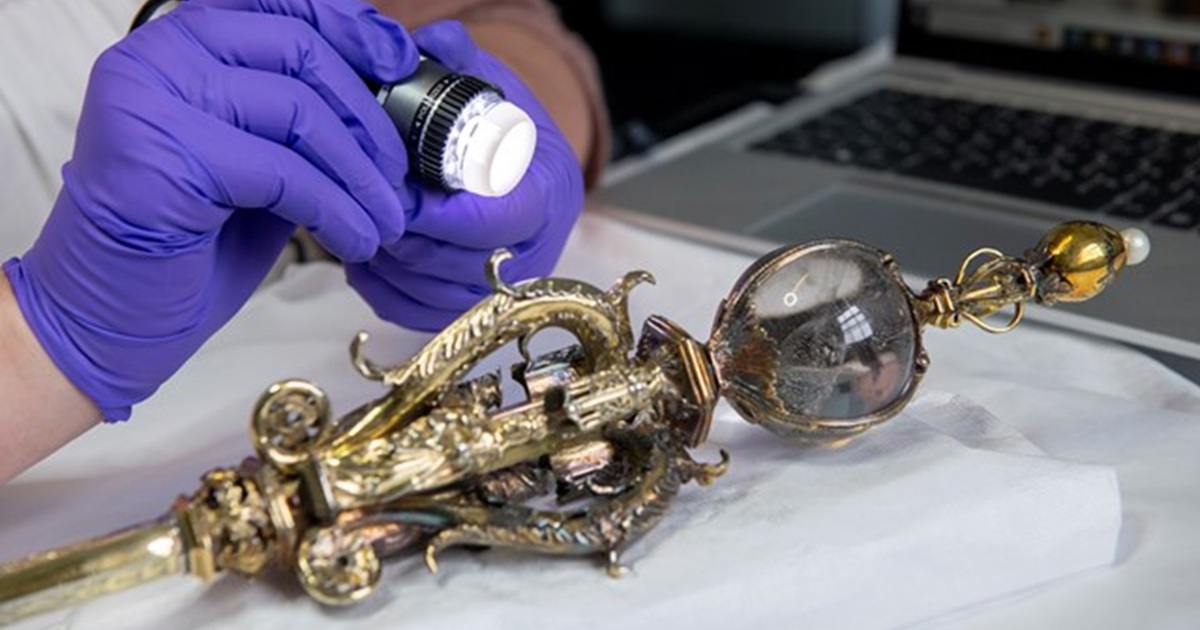
The Honours of Scotland – the oldest crown jewels in Britain and among the oldest in Europe – have collectively returned to display at Edinburgh Castle after undergoing the most significant conservation work in their history.
The Honours, which consist of the Crown, Sceptre, and Sword of State, have held profound historical significance in Scotland for centuries. They were first used together at the coronation of Mary, Queen of Scots, in 1543, and the Crown and Sceptre were presented to King Charles III at the National Service of Thanksgiving and Dedication at St Giles’ Cathedral in Edinburgh earlier this year.
Using a delicate touch and fine instruments, experts from Historic Environment Scotland (HES) cleaned the Honours to reduce tarnish and remove build-up of dust and grease. Though the Honours are made of enduring materials, their age and historic use has made them very fragile, and much of the cleaning process took place under a microscope to monitor any potential changes in their condition. The project took place over several months, with individual items taken off display at scheduled points as part of the programme.
Reed Hudson, Senior Metals Conservator at HES who led the conservation work, said:
The Honours of Scotland are unique among the HES Collections, and we want to ensure they always look their best when visitors come from near and far to see them. We undertake regular cleaning and condition checking of the Honours, but this project marks the first time they have undergone such significant conservation work in their long history.
“It’s very rare that conservators can focus on just one project in this way and being able to spend this much time with the Honours has been a once in a lifetime experience. It has allowed me to really enjoy small details that I might have missed otherwise, like the figures of the saints engraved on the blade of the sword, or the beautiful floral motifs incorporated into the designs of the sceptre and scabbard.
“We are continually developing our methods of analysis and care to ensure that we are safeguarding our national treasures in the best possible way. This project has allowed us to learn more about the Honours and their history, and we hope to share our findings in the new year. Luckily, visitors don’t need to wait that long to see the Honours again as they are now back on display together!”
Whilst conserving the Honours, the team also conducted analysis through a range of techniques, including X-radiography, portable X-Ray Fluorescence, and optical microscopy. This scientific analysis has revealed some intriguing new details about the Crown, showing that several gem settings on the Crown have been affixed with different kinds of pins throughout its long life. X-radiography will help identify the metals of which these pins were made, which will aid in the understanding of when these repairs took place. The conserved Honours have also been digitally scanned to ensure that online documentation of these important objects is as comprehensive as possible.
This dedicated work has been undertaken to ensure the Honours can continue to play an active role in Scottish ceremonial events for many years to come and can continue to charm visitors, who can book their tickets to Edinburgh Castle to view the Honours of Scotland now.
About the Honours of Scotland
- The Honours of Scotland, comprising the Crown of Scotland, the Sceptre, and the Sword of State, are the oldest Crown jewels in Britain.
- Their centrepiece is the Crown of Scotland, crafted of gold and silver and laden with 94 pearls and 43 gemstones including diamonds, garnets and amethysts. James V had the Crown made in 1540, likely in part from the earlier Scottish Crown which had been damaged, and first wore it at the coronation of Mary of Guise that same year.
- The Sceptre is thought to have been a gift to James IV from Pope Alexander VI in 1494. This ceremonial staff is an example of High Renaissance Italian craftsmanship, with the finial formed from a globe of polished rock crystal and held up by stylised dolphins and three figures depicting St Andrew, St James and the Virgin Mary. On top of the crystal globe sits a gold orb, capped with a single large pearl.
- The Sword of State was gifted to James IV by Pope Julius II in 1507 and represents an exceptionally high quality of decoration. The arms of Pope Julius were used as the theme for the Sword handle design, with oak trees and acorns symbolising the risen Christ and dolphins signifying Christ’s Church. The blade of the Sword is in a very fragile condition and was retired from use some years ago with consent of the monarch.
- The Honours of Scotland are housed in the Crown Room at Edinburgh Castle.
About Historic Environment Scotland (HES)
- We are the lead body for Scotland’s historic environment, a charity dedicated to the advancement of heritage, culture, education and environmental protection. It is at the forefront of researching and understanding the historic environment and addressing the impacts of climate change on its future, investigating and recording architectural and archaeological sites and landscapes across Scotland and caring for more than 300 properties of national importance. We are also the lead on delivering Scotland’s strategy for the historic environment, Our Past, Our Future.
- Historic Scotland, Scran, Canmore, The National Collection of Aerial Photography (NCAP), The Engine Shed, Stirling Castle, and Edinburgh Castle are sub-brands of HES.
- View our press pack and keep up to date by registering to receive our media releases. Already registered? You can unsubscribe at any time by following the unsubscribe link, included in every email.
Follow HES
X: @HistEnvScot | @welovehistory
Facebook: @HistoricEnvScotland | @VisitHistoricScotland
Instagram: @HistEnvScot | @historicscotland
Blog
LinkedIn
For further information, please contact:
Robin Kepple
Historic Environment Scotland Media Office
07721 959 962
[email protected]